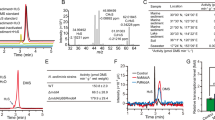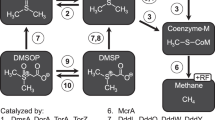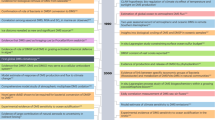Abstract
ATMOSPHERIC dimethyl sulphide, arising from marine algae, cyanobacteria and salt marsh plants such as Spartina, is the principal sulphur compound entering the atmosphere from terrestrial and aquatic environments 1–6. Methanesulphonic acid (CH3SO3H; MSA) has been identified as a major product of the photochemical oxidation in the atmosphere of dimethyl sulphide1–3,5,7–9. Dimethyl sulphide and MSA are thus predominantly, if not exclusively, biogenic in origin, and are the main gaseous links in the biogeochemical sulphur cycle. MSA is a stable compound, not undergoing photochemical decomposition3, so its removal from the atmosphere is by wet and dry deposition. MSA partitions into the aerosol phase, as well as nucleating droplet formation, and is deposited in rain and snow. Analysis of Antarctic ice cores10 gives evidence of its global deposition over many thousands of years. The subsequent fate of MSA deposited on land was unknown. Here we describe terrestrial bacteria that grow on MSA. Their activities in the natural environment would result in the mineralization of MSA to carbon dioxide and sulphate, thus completing our understanding of this part of the sulphur cycle.
This is a preview of subscription content, access via your institution
Access options
Subscribe to this journal
Receive 51 print issues and online access
$199.00 per year
only $3.90 per issue
Buy this article
- Purchase on Springer Link
- Instant access to full article PDF
Prices may be subject to local taxes which are calculated during checkout
Similar content being viewed by others
References
Watts, S. F., Brimblecombe, P. & Watson, A. J. Atmos. Environ. 24 A, 353–359 (1990).
Hatakeyama, S., Okuda, M. & Akimoto, H. Geophys. Res. Lett. 9, 583–586 (1982).
Andreae, M. O. in The Role of Air-Sea Exchange in Geochemical Cycling (ed. Buat-Menard, P.) 5–25, 331–362 (Reidel, New York, 1986).
Dacey, J. W. H., King, G. M. & Wakeham, S. G. Nature 330, 643–645 (1987).
Kelly, D. P. & Smith, N. A. Adv. microb. Ecol. 11, 345–385 (1990).
Ferek, R. J., Chatfield, R. B. & Andreae, M. O. Nature 320, 514–516 (1986).
Berresheim, H. J. J. geophys. Res. 92, 245–262 (1987).
Berresheim, H. et al. J. atmos. Chem. 10, 341–370 (1990).
Grosjean, D. Envir. Sci. Technol. 18, 460–468 (1984).
Saigne, C. & Legrand, M. Nature 330, 240–242 (1987).
Smith, A. L. & Kelly, D. P. J. gen. Microbiol. 115, 377–384 (1979).
Kelly, D. P. & Kuenen, J. G. in Aspects of Microbial Metabolism and Ecology (ed. Codd, G. A.) 211–240 (Academic, London, 1984).
Owens, J. D. & Keddie, R. M. J. appl. Bact. 32, 338–347 (1969).
Kelly, D. P. & Wood, A. P. in Microbial Growth on C-1 Compounds, Fourth Symposium (eds Crawford, R. L. & Hanson, R. S.) 324–329 (American Society for Microbiology, Washington DC, 1984).
Dahl, J. S., Mehta, R. J. & Hoare, D. S. J. Bact. 109, 916–921 (1972).
Colby, J., Dalton, H. & Whittenbury, R. A. Rev. Microbiol. 33, 481–517 (1979).
Daughton, C. G., Cook, A. M. & Alexander, M. FEMS microb. Lett. 5, 91–93 (1979).
Kung, H. F. & Wagner, C. Biochem. J. 116, 257–265 (1970).
Wagner, C., Lusty, S. M., Kung, F. & Rogers, N. L. J. biol. Chem. 242, 1287–1293 (1967).
Thysse, G. J. E. & Wanders, T. H. Antonie van Leeuwenhoek J. microb. Serol. 38, 56–63 (1972).
Thysse, G. J. E. & Wanders, T. H. Antonie van Leeuwenhoek J. microb. Serol. 40, 25–37 (1974).
Author information
Authors and Affiliations
Rights and permissions
About this article
Cite this article
Baker, S., Kelly, D. & Murrell, J. Microbial degradation of methanesulphonic acid: a missing link in the biogeochemical sulphur cycle. Nature 350, 627–628 (1991). https://doi.org/10.1038/350627a0
Received:
Accepted:
Issue Date:
DOI: https://doi.org/10.1038/350627a0
This article is cited by
-
Methanesulfonic Acid (MSA) in Hydrometallurgy
Journal of Sustainable Metallurgy (2023)
-
Green synthesis of carbon solid acid catalysts using methane sulfonic acid and its application in the conversion of cellulose to platform chemicals
Cellulose (2022)
-
Electro-Deposition Behavior in Methanesulfonic-Acid-Based Lead Electro-Refining
Journal of Sustainable Metallurgy (2021)
-
Valorization of chitosan into levulinic acid by hydrothermal catalytic conversion with methanesulfonic acid
Korean Journal of Chemical Engineering (2018)
-
Enhanced Ion Chromatographic Speciation of Water-Soluble PM\(_{2.5}\) to Improve Aerosol Source Apportionment
Aerosol Science and Engineering (2017)
Comments
By submitting a comment you agree to abide by our Terms and Community Guidelines. If you find something abusive or that does not comply with our terms or guidelines please flag it as inappropriate.



